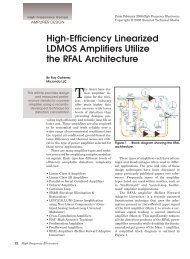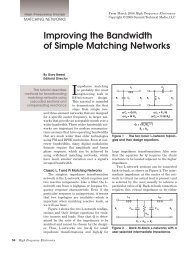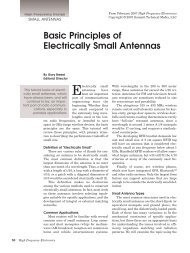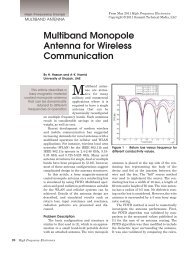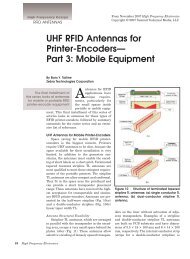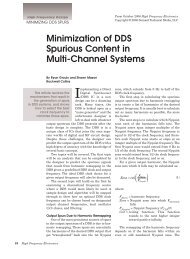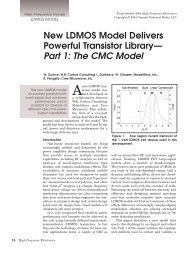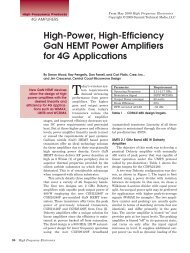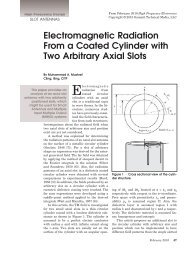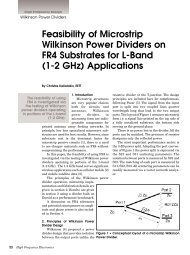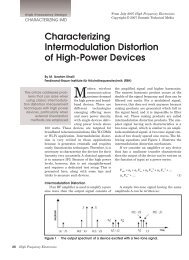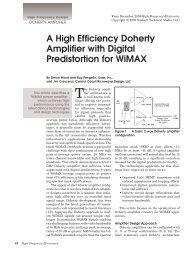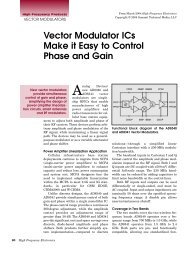The Future of Instrumentation - High Frequency Electronics
The Future of Instrumentation - High Frequency Electronics
The Future of Instrumentation - High Frequency Electronics
Create successful ePaper yourself
Turn your PDF publications into a flip-book with our unique Google optimized e-Paper software.
Table 2 • Power level values at the output ports.<br />
Conclusions<br />
An analogue IF processor has been designed, built<br />
and characterized in Yebes laboratories to adapt the output<br />
signal <strong>of</strong> the 40 meter radio telescope VLBI receivers<br />
to the input frequency range <strong>of</strong> the FFT spectrometer<br />
(modes C and D).<br />
<strong>The</strong> final performance <strong>of</strong> the IF processor is summarized<br />
as follows:<br />
• <strong>The</strong> input and output return losses are always better<br />
than 13 dB and 15 dB, respectively.<br />
• <strong>The</strong> processor has a mean power gain <strong>of</strong> approximately<br />
25 dB (± 1.5 dB) on its linear zone.<br />
• <strong>The</strong> output power at -1 dB compression point is +11<br />
dBm for the LHCP channel and +10 dBm for the<br />
RHCP channel.<br />
Figure 11 • Uncalibrated spectrum <strong>of</strong> SiO maser<br />
emission at 86 GHz from IK-Tau star.<br />
Table 3 • Power levels study for the proper operation <strong>of</strong> the FFTS.<br />
Figure 10 • Spectrum on each port <strong>of</strong> the IF processor<br />
in the backend room.<br />
Currently, the processor is installed in the backend<br />
room <strong>of</strong> the radio telescope. It is in operation and has an<br />
excellent performance. It is being used for the detection <strong>of</strong><br />
molecular lines in different frequency bands. For instance,<br />
Figure 11 shows a 7 KHz resolution spectrum <strong>of</strong> the silicon<br />
monoxide (SiO) maser at 86 GHz from IK-Tau star.<br />
About the Authors:<br />
José A. López-Pérez received his Degree in<br />
Telecommunication Engineering in 1996 and his<br />
Doctorate in 2012, both from the Polytechnic University<br />
<strong>of</strong> Madrid. After finishing his degree, he joined the<br />
Institut de Radio Astronomie Millimétrique (IRAM) in<br />
Grenoble (France) for two years. After this, he became<br />
part <strong>of</strong> the staff <strong>of</strong> the Yebes Astronomy Center (CAY) in<br />
Spain, where he currently works. He is responsible for the<br />
design and construction <strong>of</strong> the radio astronomy receivers,<br />
for the holography measurements <strong>of</strong> the 40 meter radio<br />
telescope surface and the monitoring <strong>of</strong> the RFI environment.<br />
Contact information: +34 949290311 (Ext. 205);<br />
ja.lopezperez@oan.es.<br />
David Cuadrado-Calle received his Bachelor’s Degree<br />
in Telecommunication Systems Engineering in 2010 and<br />
his Master’s Degree in Information<br />
and Communication Technologies in<br />
2012, both from the University <strong>of</strong><br />
Alcalá (Spain). He has worked at the<br />
receivers division <strong>of</strong> the Yebes<br />
Astronomy Center (CAY) for more<br />
than one year and his areas <strong>of</strong> interest<br />
are related to RF and microwave<br />
circuits and systems. Contact information:<br />
+34 626967299; d.cuadrado@oan.es.<br />
35



